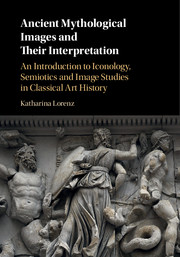 Ancient Mythological Images and their Interpretation
Ancient Mythological Images and their Interpretation 4 - Introducing semiotics
from SEMIOTICS
Published online by Cambridge University Press: 05 August 2016
Summary
The contemporaries and rivals of Zeuxis were Timanthes, Androcydes, Eupompus, Parrhasius. This last, it is recorded, entered into a competition with Zeuxis. Zeuxis produced a picture of grapes so dexterously represented that birds began to fly down to eat from the painted vine. Whereupon Parrhasius designed so lifelike a picture of a curtain that Zeuxis, proud of the verdict of the birds, requested that the curtain should now be drawn back and the picture displayed. When he realised his mistake, with a modesty that did him honour, he yielded up the palm, saying that whereas he had managed to deceive only birds, Parrhasius had deceived an artist.
Pliny, HN 35.64–6The enduring relevance of Pliny's anecdote is remarkable: indeed, unless art history finds the strength to modify itself as a discipline, the anecdote will continue to sum up the essence of working assumptions still largely unquestioned.
Bryson 1983: 1Norman Bryson's use of the anecdote about the contest between the Greek painters is indicative both of the relationship of the study of ancient art and the method of semiotics and of the functioning of semiotics more generally. Bryson's summoning of an ancient analogy for his argument is rather exceptional in semiotics studies: in contrast to iconology, the field of semiotics exists quite happily without reference to, or reverence for, antiquity. Semiotics does not require the legitimatisation Panofsky had sought by enlisting antiquity as a passepartout, for the simple reason that it lacks any investment in a single, irrefutable truth – the search for which is at the heart of iconology.
More crucially, the anecdote throws into relief the problems that arise from this disinvestment from truth for the study of ancient art and art more generally. On the surface, Bryson employs the anecdote to argue that no such thing as a natural attitude exists, a claim that is central to the turning away from the concept of a single truth. But dig deeper and Pliny's anecdote highlights how the methodological framework of semiotics raises the stakes for interpretation: we have only Pliny's word for both the contest and the pictures involved in it. Our relationship to a picture is therefore analogous to that which exists between what Zeuxis thinks he sees – a curtain – and what Parrhasius actually shows him – the representation of a curtain.
- Type
- Chapter
- Information
- Ancient Mythological Images and their InterpretationAn Introduction to Iconology, Semiotics and Image Studies in Classical Art History, pp. 103 - 117Publisher: Cambridge University PressPrint publication year: 2016


